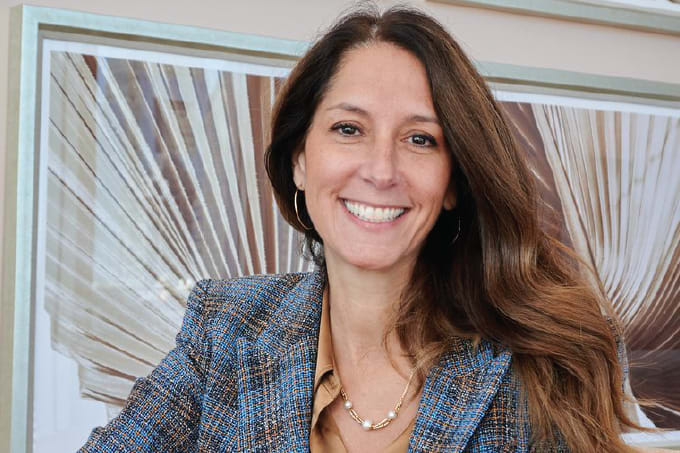
Approximately 35,000 patients are diagnosed with multiple myeloma annually in Europe. Globally, that figure is close to 188,000. These patients are typically treated with a combination of therapies across different lines, and drugs are often reused. Unfortunately, the condition remains incurable. Over time, patients exhaust their treatment options due to disease progression or relapse.
This is the backdrop against which the bispecific antibody Lynozyfic (linvoseltamab) was developed by Regeneron. The first-in-human trial was specifically for patients with relapsed/refractory multiple myeloma who had been exposed to at least three prior lines of therapy: immunomodulators, proteasome inhibitors, and anti-CD38 monoclonal antibodies. The response rates in this study were remarkable, with an overall response rate of 71 percent, and 50 percent of patients achieving a complete response or better, meaning there was no detectable evidence of disease.
Karen Rodriguez-Lorenc, Vice President, Therapeutic Area Lead for Hematology Oncology within the Hematology Clinical Development Unit, Regeneron, tells us about the journey so far, and the future of bispecific antibodies.
During development, when did you begin to realize that the therapy might succeed and reach regulatory approval?
I joined Regeneron five years ago, and the program was already underway – not at the very beginning, but certainly progressing. What was striking, and quite unique, was that we observed responses across all dose levels – even the lowest. Typically, efficacy emerges only at higher doses, but here, patients with the lowest doses experienced strong partial responses.
By the time I joined, our focus was on optimizing the dosage and identifying the regimen to carry forward. But from the outset, there was clear evidence that the therapy was effective.
How does linvoseltamab work and how was it discovered?
Linvoseltamab is a fully human bispecific antibody developed in-house at Regeneron. This matters because antibodies with non-human components can trigger immune reactions. Fully human antibodies reduce that risk.
As a bispecific, linvoseltamab has two binding arms: one targets BCMA (B-cell maturation antigen) on multiple myeloma cells, and the other targets CD3 on T cells. The drug bridges the two cells, activating the T cell and enabling it to kill the cancer cell. That’s its fundamental mechanism of action.
In terms of safety, linvoseltamab demonstrated one of the lowest rates of cytokine release syndrome (CRS) – observed in 46 percent of patients. Of those, 35 percent had grade 1 CRS, 10 percent had grade 2, and only a single patient experienced grade 3 CRS. We also monitored infections, which were most common during the first six months of treatment and tended to decrease over time. This may be due to better disease control and the tapering of linvoseltamab dosing.
We believe linvoseltamab is possibly the best-in-class BCMA×CD3 bispecific antibody, based on its efficacy, safety, and convenient administration schedule. The regimen starts with weekly dosing, progresses to biweekly dosing, and after six months, patients with a very good partial response or better can transition to monthly dosing. This structure is patient-friendly and supports both caregivers and the broader healthcare system.
What role did Regeneron’s VelocImmune technology play in the development of linvoseltamab?
Linvoseltamab was developed using two key Regeneron platforms: VelocImmune and Veloci-Bi. VelocImmune uses genetically modified mice with humanized immune systems to produce fully human antibodies. This greatly reduces the likelihood of immune rejection.
Veloci-Bi is the platform we use to generate bispecific antibodies.
What studies have been completed with linvoseltamab so far?
The pivotal study that supported both EMA and FDA approval was our first-in-human trial for relapsed/refractory multiple myeloma after three prior therapies.
Building on that, we have a range of ongoing studies: combinations with standard of care and novel agents (our umbrella study); monotherapy in transplant-eligible and -ineligible patients; studies in amyloidosis, high-risk smoldering myeloma, and monoclonal gammopathy of undetermined significance (MGUS); and a confirmatory phase comparing linvoseltamab to elotuzumab plus pomalidomide and dexamethasone in the second and third-line setting. We’re also planning studies in earlier lines of therapy.
What were the biggest challenges Regeneron faced during development?
Many of the challenges aren’t unique to Regeneron, but one major issue is clinical trial execution. Most trials are conducted in academic centers, but we need to ensure patient enrollment truly reflects the real-world population.
Reaching underrepresented communities and ensuring diverse patient recruitment is critical. We’re tackling this by educating physicians, patients, and communities, and carefully selecting our trial sites to support global representation.
What’s your outlook on the future of bispecific antibodies?
There are enormous opportunities. We’re exploring monotherapies and combinations, especially in multiple myeloma. Patients are often treated with multiple drugs simultaneously, and while this can enhance efficacy through additive or synergistic effects, it also raises safety concerns.
The strong results with linvoseltamab monotherapy in relapsed/refractory disease make us wonder: can we simplify regimens in earlier lines of therapy while maintaining efficacy and improving safety?
We’re also studying earlier intervention in precursor conditions to prevent progression to full-blown multiple myeloma. And beyond oncology, we’re testing a BCMA×CD3 bispecific in patients with chronic kidney disease awaiting transplantation. So yes, I believe bispecifics can transform treatment in cancer and beyond.
You’ve been with Regeneron for five years. What are the standout moments so far?
There have been many. Seeing patients respond even at the lowest dose levels was incredible. Identifying the right regimen was a major milestone. Gaining regulatory approvals and presenting our data at conferences are also highlights.
But what stays with me most is hearing feedback directly from physicians and patients about how our work is impacting lives. That’s what motivates us to keep going every day.




